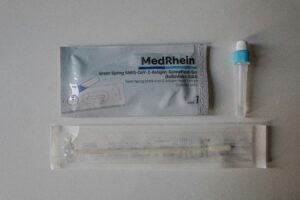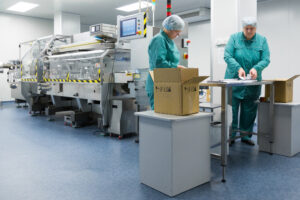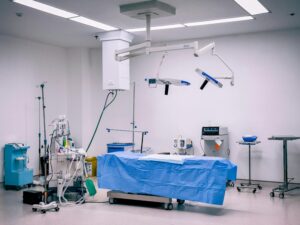U.S. Deliveries: The Competitive Advantage of Border Manufacturing
Border manufacturing in Ciudad Juárez, supported by a logistics hub in El Paso, is transforming how U.S. OEMs receive medical devices. This setup offers numerous benefits, including rapid deliveries, improved transit times, and increased product availability.
The result is faster market access, seamless logistics, and reliable medical device delivery backed by strong traceability systems. And all of this is only allowed thanks to the strategic infrastructure that integrates everything into a seamless pipeline.
The Importance of Export Readiness in Medical Manufacturing
Exporting regulated products, such as medical devices, from Mexico presents its own set of hurdles for OEMs. While border manufacturing can provide a significant edge, that advantage only comes when companies are fully prepared.
One major obstacle is regulatory complexity. Manufacturers must secure approvals from Mexico´s COFEPRIS while also meeting FDA requirements. This dual process adds layers of work, making the use of traceability systems vital.
Another challenge lies in synchronizing the supply chain. The shipment requires a deep understanding of U.S. logistics. All of this, from customs clearance to last-mile delivery, ensures continuous goods flow while minimizing customs-related lead times and cost overruns.
Finally, there is the risk of delays or non-compliance. Mistakes in paperwork or gaps in traceability can stop a shipment in its tracks. This disrupts medical device delivery schedules.
Understanding Mexico’s Role as a MedTech Export Hub
The Juárez–El Paso region has emerged as a critical node in border manufacturing, driving cross-border medical technology (MedTech) flows. Thanks to its strategic location, it serves as a bridge between Mexican production capabilities and U.S. logistics networks.
Below are the key operational strengths of the Juárez–El Paso manufacturing corridor. With these points, it´s obvious why so many nearshore OEM operations choose to base production and distribution in this area:
- Proximity to the U.S. markets. This factor slashes transit time and shipping costs. Additionally, Mexico’s industrial zones and free-trade advantages under the USMCA further enhance this logistics edge.
- In the Tijuana hub, there are more than 74,000 employees. It is the first in Latin American exports and the 10th globally in medical device manufacturing.
- Border locations. There are areas equipped with customs offices and specialized manufacturing infrastructure. All of this is designed to ensure that regulated goods move smoothly across the border.
Together, these advances make the regions one of the most efficient and dependable MedTech hubs in North America. For OEMs pursuing a border manufacturing strategy, it stands as a proven model.
The Juárez-El Paso corridor blends a highly trained workforce with modern facilities. It also has immediate access to both the Mexican and U.S. markets, creating a robust base for cross-border production and distribution.
Key Export Elements: Documentation, Logistics, and Coordination
Ensuring efficient export in border manufacturing hinges on operational precision. However, it also depends on a seamless connection between production, shipping and delivery.
Every step, from labelling to customs and clearance, must be executed flawlessly meeting regulatory requirements and keeping shipments on schedule. To achieve this, it is vital to know the three operational pillars that play a critical role in this process:
- Documentation. Proper labelling, batch records, and regulatory filings for both COFEPRIS and FDA must be in place. This prevents shipment delays and ensures smooth customs processing.
- Logistics: Warehousing near the border facilitates rapid dispatch. Also, familiar U.S. logistics networks provide predictable and efficient delivery schedules.
- Coordination: Collaboration among manufacturing, warehousing, traceability systems, and shipping ensures smooth execution. So that products can be delivered without any interruption.
However, there is more than these main pillars. Because successful border operations also depend on specific core capabilities that create consistency and reliability in exports, which are:
- Labelling compliant with dual regulatory regimes.
- Customs clearance expertise for faster processing.
- Just-in-time staging to support timely medical device delivery.
- Climate-controlled storage and efficient warehousing near the border.
- Real-time tracking and traceability systems for visibility and compliance.
These are the pillars that transform border manufacturing into a competitive advantage for OEMs targeting U.S. markets. Besides, when applied together, products not only move efficiently but also provide a lasting competitive advantage.
Managing Compliance Across Borders
Reliably meeting both Mexican and U.S. regulatory standards is a linchpin in cross-border medical device manufacturing.
Mexican-based OEMs must comply with COFEPRIS regulations, while exporters must also align with FDA and ISO 13485 standards. In this case, the most reputable border manufacturing partners offer dual-system competency:
- GP Logistics. Offers include warehousing, labelling, real-time GPS and RFID tracking, as well as customs coordination. This helps maintain traceability systems during cross-border operations.
- Manufacturers close to the border. This factor reduces the risk by relying on experienced logistics partners who are well-versed in both regulatory frameworks and compliance requirements.
This integrated approach safeguards delivery timelines and ensures compliance into every step of the process.
By leveraging partners who master both regulatory landscapes, OEMs gain the agility to adapt quickly to policy changes. As well as avoiding costly delays, and maintaining a consistent flow of medical device delivery into U.S. markets.
How RexMed Streamlines Medical Device Export Processes
RexMed Health is a real-life example. Mainly because it illustrates how a border-based OEM can deliver regulatory and logistical excellence, to observe this, we have to look closely at its setup and strengths:
- Based in El Paso, TX. RexMed operates in accordance with ISO 13485 and holds both FDA and COFEPRIS certifications. As a result, it raises regulatory expectations across borders.
- M&P Doniphan Logistics. Our El Paso warehousing and distribution center handles cross-dock operations, customs, storage, and distribution.
- RexMed’s capabilities. This includes clean room assembly, extrusion, RF sealing and medical device delivery. All of these elements make the exports more efficient.
- Strategic location. We manage import and export documentation, sterilization, testing, and distribution. Of course, all within U.S. logistics networks.
Hence, they embody a nearshore OEM model, which combines proximity, compliance, and logistics orchestration. These elements enable the expedited delivery of medical devices into U.S. markets.
Turning border manufacturing into a strategic edge
With border manufacturing, companies can master the complex world of medical device delivery. Hence, nearshore OEM models could redefine national supply chains.
This can serve as the global blueprint for delivering rapid, resilient, and compliant medical advice. Border manufacturing in Ciudad Juárez, supported by a logistics hub in El Paso, is transforming how U.S. OEMs receive medical devices. This setup offers numerous benefits, including rapid deliveries, improved transit times, and increased product availability.
The result is faster market access, seamless logistics, and reliable medical device delivery backed by strong traceability systems. And all of this is only allowed thanks to the strategic infrastructure that integrates everything into a seamless pipeline.
The Importance of Export Readiness in Medical Manufacturing
Exporting regulated products, such as medical devices, from Mexico presents its own set of hurdles for OEMs. While border manufacturing can provide a significant edge, that advantage only comes when companies are fully prepared.
One major obstacle is regulatory complexity. Manufacturers must secure approvals from Mexico´s COFEPRIS while also meeting FDA requirements. This dual process adds layers of work, making the use of traceability systems vital.
Another challenge lies in synchronizing the supply chain. The shipment requires a deep understanding of U.S. logistics. All of this, from customs clearance to last-mile delivery, ensures continuous goods flow while minimizing customs-related lead times and cost overruns.
Finally, there is the risk of delays or non-compliance. Mistakes in paperwork or gaps in traceability can stop a shipment in its tracks. This disrupts medical device delivery schedules.
Understanding Mexico’s Role as a MedTech Export Hub
The Juárez–El Paso region has emerged as a critical node in border manufacturing, driving cross-border medical technology (MedTech) flows. Thanks to its strategic location, it serves as a bridge between Mexican production capabilities and U.S. logistics networks.
Below are the key operational strengths of the Juárez–El Paso manufacturing corridor. With these points, it´s obvious why so many nearshore OEM operations choose to base production and distribution in this area:
- Proximity to the U.S. markets. This factor slashes transit time and shipping costs. Additionally, Mexico’s industrial zones and free-trade advantages under the USMCA further enhance this logistics edge.
- In the Tijuana hub, there are more than 74,000 employees. It is the first in Latin American exports and the 10th globally in medical device manufacturing.
- Border locations. There are areas equipped with customs offices and specialized manufacturing infrastructure. All of this is designed to ensure that regulated goods move smoothly across the border.
Together, these advances make the regions one of the most efficient and dependable MedTech hubs in North America. For OEMs pursuing a border manufacturing strategy, it stands as a proven model.
The Juárez-El Paso corridor blends a highly trained workforce with modern facilities. It also has immediate access to both the Mexican and U.S. markets, creating a robust base for cross-border production and distribution.
Key Export Elements: Documentation, Logistics, and Coordination
Ensuring efficient export in border manufacturing hinges on operational precision. However, it also depends on a seamless connection between production, shipping and delivery.
Every step, from labelling to customs and clearance, must be executed flawlessly meeting regulatory requirements and keeping shipments on schedule. To achieve this, it is vital to know the three operational pillars that play a critical role in this process:
- Documentation. Proper labelling, batch records, and regulatory filings for both COFEPRIS and FDA must be in place. This prevents shipment delays and ensures smooth customs processing.
- Logistics: Warehousing near the border facilitates rapid dispatch. Also, familiar U.S. logistics networks provide predictable and efficient delivery schedules.
- Coordination: Collaboration among manufacturing, warehousing, traceability systems, and shipping ensures smooth execution. So that products can be delivered without any interruption.
However, there is more than these main pillars. Because successful border operations also depend on specific core capabilities that create consistency and reliability in exports, which are:
- Labelling compliant with dual regulatory regimes.
- Customs clearance expertise for faster processing.
- Just-in-time staging to support timely medical device delivery.
- Climate-controlled storage and efficient warehousing near the border.
- Real-time tracking and traceability systems for visibility and compliance.
These are the pillars that transform border manufacturing into a competitive advantage for OEMs targeting U.S. markets. Besides, when applied together, products not only move efficiently but also provide a lasting competitive advantage.
Managing Compliance Across Borders
Reliably meeting both Mexican and U.S. regulatory standards is a linchpin in cross-border medical device manufacturing.
Mexican-based OEMs must comply with COFEPRIS regulations, while exporters must also align with FDA and ISO 13485 standards. In this case, the most reputable border manufacturing partners offer dual-system competency:
· GP Logistics. Offers include warehousing, labelling, real-time GPS and RFID tracking, as well as customs coordination. This helps maintain traceability systems during cross-border operations.
· Manufacturers close to the border. This factor reduces the risk by relying on experienced logistics partners who are well-versed in both regulatory frameworks and compliance requirements.
This integrated approach safeguards delivery timelines and ensures compliance into every step of the process.
By leveraging partners who master both regulatory landscapes, OEMs gain the agility to adapt quickly to policy changes. As well as avoiding costly delays, and maintaining a consistent flow of medical device delivery into U.S. markets.
How RexMed Streamlines Medical Device Export Processes
RexMed Health is a real-life example. Mainly because it illustrates how a border-based OEM can deliver regulatory and logistical excellence, to observe this, we have to look closely at its setup and strengths:
- Based in El Paso, TX. RexMed operates in accordance with ISO 13485 and holds both FDA and COFEPRIS certifications. As a result, it raises regulatory expectations across borders.
- M&P Doniphan Logistics. Our El Paso warehousing and distribution center handles cross-dock operations, customs, storage, and distribution.
- RexMed’s capabilities. This includes clean room assembly, extrusion, RF sealing and medical device delivery. All of these elements make the exports more efficient.
- Strategic location. We manage import and export documentation, sterilization, testing, and distribution. Of course, all within U.S. logistics networks.
Hence, they embody a nearshore OEM model, which combines proximity, compliance, and logistics orchestration. These elements enable the expedited delivery of medical devices into U.S. markets.
Turning border manufacturing into a strategic edge
With border manufacturing, companies can master the complex world of medical device delivery. Hence, nearshore OEM models could redefine national supply chains.
This can serve as the global blueprint for delivering rapid, resilient, and compliant medical advice.






